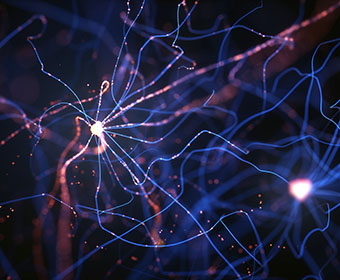
(May 8, 2019) – Dysfunctions and malformations in the scaffold of a cell are thought to contribute to heart muscle weakness, neurodegenerative disease and even deafness. Now biophysics research at The University of Texas at San Antonio (UTSA) has taken a closer look at a cell’s cytoskeleton and found a new purpose: It aids in energy transfer and information processing in neurons.
Marcelo Marucho, an associate professor in the UTSA Department of Physics and Astronomy, studies, in particular, the cytoskeleton’s actin filaments and microtubules for the past 4 years. He works to track how the transfer of energy along these structures impacts cellular function.
The research proposes that structural changes in the filaments (mutations) and alteration in the biological fluids break down the equilibrium and competition between the molecular mechanisms that dominate the bundling and transmission properties of cytoskeleton filaments in normal conditions. This, in turn, yields impaired assembly and defective electric signal propagation along these filaments leading to cellular pathology.
Age and hereditary factors are known to contribute to the development of diseases, however Marucho’s research provides insight into how the cytoskeleton’s electrical properties contribute to the degradation of a cell.
“There is evidence that filaments conduct electricity, like an electrical cord,” said Marucho, who combines both biology and physics to understand what he calls the bionanowire—a cell’s electrical cable. “The filaments, F-Actin and microtubules, are able to propagate electrical impulses inside neurons. This property is something that scientists generally haven’t considered.”
The cell’s cytoskeleton, or filaments, are responsible for a cell’s shape. They also organize cellular parts and impact a cell’s movement and division. But Marucho believes that cells cytoskeleton filaments are also capable of conducting electrical energy.
The UTSA researcher developed multi-scale models with patch clamp and light scattering experiments to determine how electricity spreads and how it affects the mechanical properties of filaments. These preliminary results will help him better understand the normal conditions that allow the cell’s bionanowire to develop.
“We also want to elucidate how the pH solution, salts including amount and type, generate the correct healthy formation of cytoskeleton structures,” said Marucho. “Biological fluid is a necessary medium to mediate the interactions between cytoskeleton filaments.”
In total, Dr. Marucho was awarded $1.5 million in research funding over four years from the National Institutes of Health (NIH) to continue his work on Actin filaments and to look more in-depth at microtubules.
This NIH grant is part of a banner year for research dollars at UTSA. In FY 2018 alone, UTSA’s total research and development expenditures reached $69.7 million.
Learn more about the Marucho Lab.
Explore a degree in the UTSA Department of Physics and Astronomy.
Celebrate UTSA’s 50th Anniversary and share social media posts about the 50th using the hashtag #UTSA50.
Connect with UTSA online at Facebook, Twitter, YouTube, Instagram and LinkedIn.
UTSA Today is produced by University Communications and Marketing, the official news source of The University of Texas at San Antonio. Send your feedback to news@utsa.edu. Keep up-to-date on UTSA news by visiting UTSA Today. Connect with UTSA online at Facebook, Twitter, Youtube and Instagram.
Move-in Day is an exciting time for incoming students. Students living in Chaparral Village move in from August 20-21. The UTSA Housing and Residence Life (HRL) team looks forward to welcoming you all and helping you settle into your room.
Chaparral VillageMove-in Day is an exciting time for incoming students. Students living in Laurel Village move in on August 22. The UTSA Housing and Residence Life (HRL) team looks forward to welcoming you all and helping you settle into your room.
Laurel VillageThe College of Sciences welcomes our newest Roadrunners to UTSA at VIVA Science! This interactive event connects students with faculty, staff, student leaders, and peers while highlighting the opportunities available across the College.
Outdoor Learning Environment 2 (OLE), Flawn Building, Main CampusWe're excited to welcome the new class of UTSA College of Liberal and Fine Arts (COLFA) students to campus! Move In To COLFA is strongly recommended for new students in COLFA because it gives you the chance to learn about the Student Success Center, learn how to do college successfully and meet new friends.
Galleria (MH 2.01), McKinney Humanities Building, Main CampusBuild connections with your Alvarez College of Business peers and learn more about the Career Compass program! This opportunity will provide fun interactions, giveaways and a chance to meet your next friend!
Richard Liu Auditorium (BB 2.01.02,) Business Building, Main CampusCelebrate the end of summer and the start off a great fall semester with The Housing Block Party! This event will have live music, carnival-style treats, artists, games, and activities galore. Come and join us for a night of fun!
Multipurpose Room/Lawn, Guadalupe Hall, Main CampusBe part of an unforgettable night as SOSA takes the field for its first public performance of the season! Experience the power, pride, and pageantry of UTSA’s marching band. Learn beloved traditions, practice cheers, and feel what it means to be a Roadrunner.
Campus Rec FieldsThe University of Texas at San Antonio is dedicated to the advancement of knowledge through research and discovery, teaching and learning, community engagement and public service. As an institution of access and excellence, UTSA embraces multicultural traditions and serves as a center for intellectual and creative resources as well as a catalyst for socioeconomic development and the commercialization of intellectual property - for Texas, the nation and the world.
To be a premier public research university, providing access to educational excellence and preparing citizen leaders for the global environment.
We encourage an environment of dialogue and discovery, where integrity, excellence, respect, collaboration and innovation are fostered.